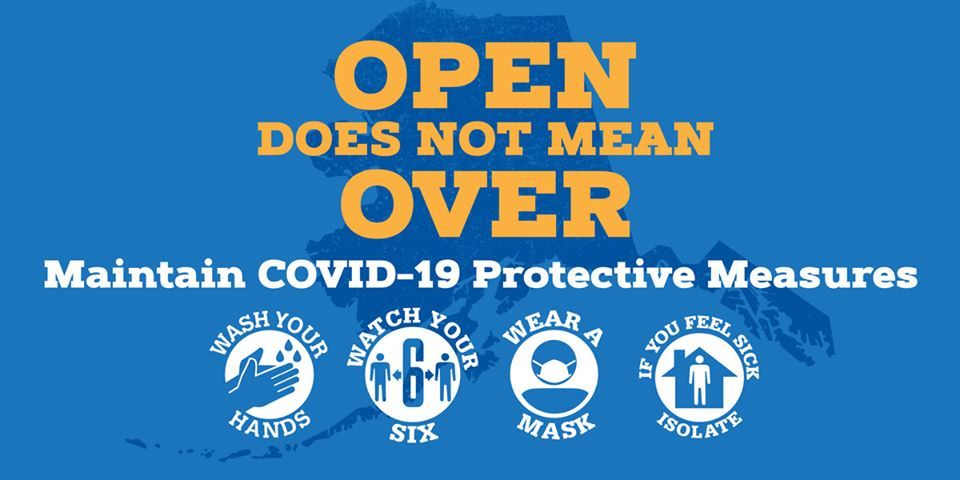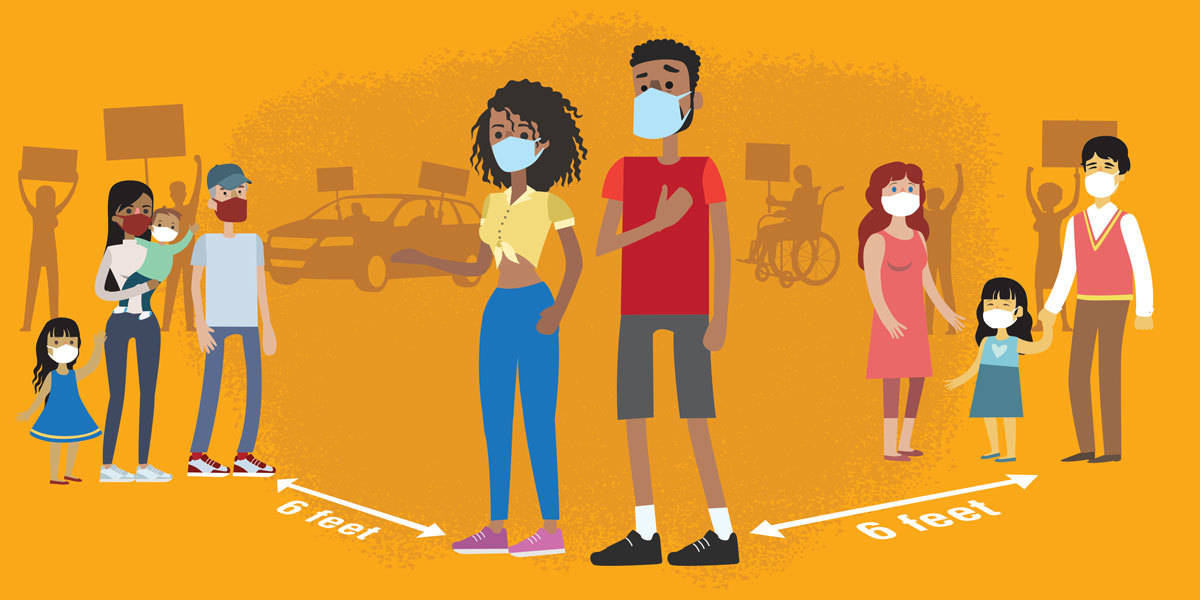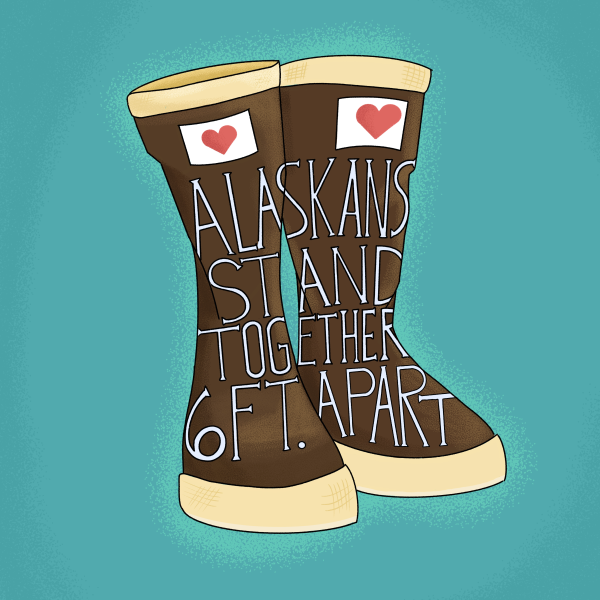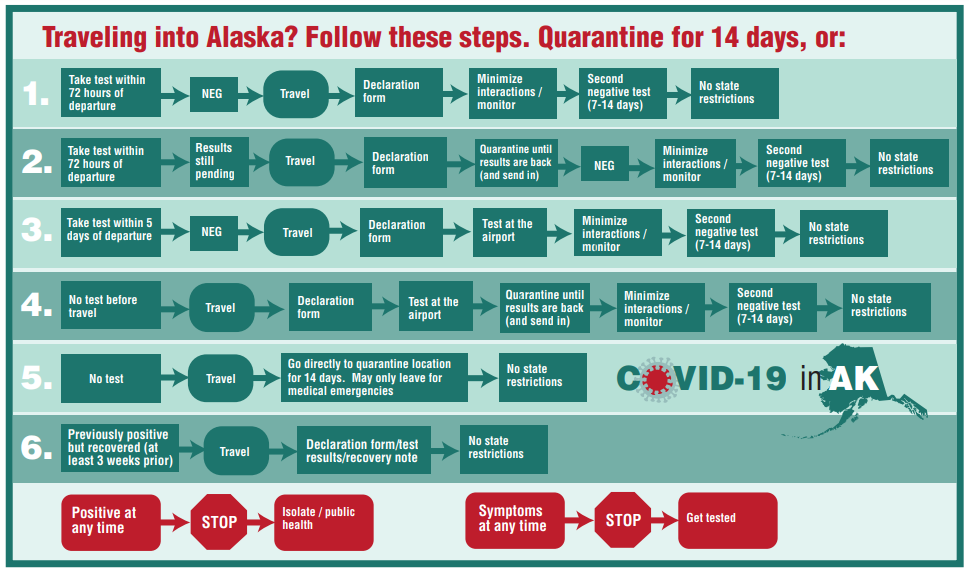Statewide COVID-19 Communications: June 16 update for partners
Alaska Department of Health sent this bulletin at 06/16/2020 08:58 AM AKDT
Dear Community Partners:
Thank you for all your continued hard work, coordination and patience under difficult circumstances. We can't thank everyone enough for the ongoing efforts to keep Alaskans healthy, safe and informed about COVID-19. If you have questions or would like something included in the next update, email items to elizabeth.manning@alaska.gov or kathleen.griffith@alaska.gov with the subject: COVID-19 Week in Review.
Travel update
Alaska Department of Health and Social Sciences (DHSS), Unified Command, the Department of Transportation & Public Facilities (DOT&PF) and many other public and private partners have been working hard with communities and emergency operations centers to quickly and efficiently implement the Governor Dunleavy's revised Health Mandate 10 that went into effect on June 6. The revised mandate provided testing options to travelers coming into Alaska as an alternative to the 14-day quarantine requirement. DHSS issued a press release on June 12 describing the changes and providing an update on how the new system is working at the airports offering testing. A new flow chart explaining the various options was also provided. Discussions are happening now at DHSS on the best way to provide regular, periodic reporting on the testing being conducted at the airports. Once those details are finalized, they'll be shared with this group.
Information is being continually updated at:
- DHSS: Health guidance for Alaska travelers
- State of Alaska: COVID-19 Traveler information
- Alaska Travel Industry Association: COVID-19 Travel Information
All mandates
Full mandates can be read online, alongside supporting documents at:
- Read all current mandates at alaska.gov/health-mandates/
- Questions about COVID-19 and the health mandates can be sent to covidquestions@alaska.gov
Case count summary: reporting data for June 5 - June 14
Alaska cases: 140
Communities involved: Anchor Point, Anchorage, Douglas, Eagle River, Fairbanks, Fritz Creek, Girdwood, Haines, Homer, Kodiak, Juneau, Kenai Peninsula Borough, Kotzebue, Nome, North Pole, Northwest Arctic Borough, Palmer, Sitka, Soldotna, Talkeetna, Wasilla, Wrangell
Cases of note: Alaska Marine Highway System ferry M/V Tustumena; Providence Transitional Care Center in Anchorage, Fairbanks Pioneer Home employee
Total as of June 14: 664
Nonresident cases: 33
Communities involved: Aleutians East Borough, Aleutians West Census Area, Municipality of Anchorage, Bethel Census Area, combined Bristol Bay and Lake & Peninsula boroughs, Fairbanks North Star Borough, City and Borough of Juneau, Kenai Peninsula Borough, Ketchikan Gateway Borough, Kodiak Island BoroughMatanuska-Susitna Borough, Sitka City and Borough, Wrangell-Petersburg Census Area,
Cases of note: Cases being identified through testing at airports of travelers entering Alaska
Total as of June 14: 76
Hospitalizations: 5
Total as of June 14: 53
Deaths: 2
Total as of June 14: 12
Recovered cases: 35
Total as of June 14: 417
Total active cases as of June 14: 235
Total tests completed as of June 14: 74,437
Percent positive as of June 14: 0.62%
Data dashboard is available at coronavirus-response-alaska-dhss.hub.arcgis.com
- Reporting of cases for Kenai Peninsula Borough (KPB) has been split into two regions: north and south. The boundaries are determined by KPB's boundaries for South Peninsula Hospital. View maps at: www.kpb.us/service-areas/south-kenai-peninsula-hospital-service-area
- The epidemiological curve title has been updated to read "Confirmed COVID-19 Cases by Onset Date" to help address confusion around cases changing from initial report date to the onset date once it is known.
- Active cases are now displayed on the data dashboard. Click on the tab next to the "Recovered Cases" tab.
- Nonresident cases data table: coronavirus-response-alaska-dhss.hub.arcgis.com/datasets/covid-cases-out-of-state/data
Please note: These summaries may differ from the data dashboard as dates, residences and other data points for the cases are adjusted over time based on interviews conducted during contact tracing. The information above is compiled from DHSS’ daily case count press releases.
CDC news
The CDC held a telebriefing on Friday, June 12. The last one of these was on March 10. Read the transcript.
The briefing focused on guidance on how to resume daily life safely and responsibly as states reopen and provided these new guidance documents, as well as discussing a CDC MMWR report discussing how Americans responded to key public health measures.
- Deciding to Go Out
- Considerations for Events and Gathering
- MMWR on Public Attitudes, Behaviors and Beliefs
Yesterday, the CDC issued another MMWR report on the disproportionate impact of the disease on vulnerable populations, including those with underlying health conditions and some racial groups. Read the full report: Coronavirus Disease 2019 Case Surveillance — United States, January 22–May 30, 2020.
For a full list of new information from the CDC, visit their What's New webpage. Attached are CDC Key Messages from June 13, 2020. These are meant for public information officers and should not be posted publicly. They are emailed to us from the National Public Health Information Coalition (NPHIC).
Open doesn't mean over

As case counts are continuing to rise in Alaska, messaging about the importance of maintaining COVID-19 protective measures is critical. DHSS has been using the wording "Open Does Not Mean Over" and has developed a video and graphics that can be shared.
Example social media post:
If we’re going to keep the lid on COVID-19, Alaskans must take prevention more seriously. Please wash your hands often, wear a cloth face covering, stay six feet apart from others and get tested at the first sign of illness. All of these protective measures must be done together to be effective.
Guidance for demonstrations

With people gathering across Alaska around the issues of human rights, equity, and justice we want to keep everyone’s health and safety in mind. Since these demonstrations are happening during a time when COVID-19 is on the rise in Alaska, and large groups can increase the risk of spread (large gatherings are considered “accelerating events” for COVID), here are some ways to have a COVID-conscious demonstration, stay safe and keep others safe:⠀
- Wear masks, and ask that all participant wear masks covering their nose, mouths, and chins⠀
- Hold the demonstration in an outdoor space⠀
- Keep 6 feet of distance between household groups (can use parking space lines or chalk circles to indicate space)⠀
- Provide options to stand farther back, or participate from a car, particularly for people who have an existing health condition or who live or work with people who do
- Consider options for digital participation (e.g. create a hashtag, event space, or thread to allow people to “attend” and share signs and thoughts from afar)
- Stay home if sick (even with mild symptoms) and encourage others to do so
- Disinfect shared surfaces and objects, such as microphones or megaphones, between speakers/users
- Provide hand sanitizer (at least 60% alcohol) & encourage participants to bring hand sanitizer
- Encourage participants to avoid touching their faces until they have returned home and washed their hands
- Practice forms of demonstration that minimize chanting/singing/yelling, as these can spread respiratory droplets. Alternatives include drums and noisemakers, silent demonstrations, written signs, etc.
- Wear appropriate eyewear (sunglasses, goggles)
- Cough into your elbow, and consider wearing a bandana around your neck to contain coughs, blow your nose, etc.
- Bring your own supplies (e.g. water bottles) and encourage people to bring their own to avoid sharing
-
Aftercare plan:
- Minimize contact with others for the next 14 days;
- Closely monitor your symptoms;
- Get tested if you have even mild cold-like symptoms; Call 211 if you do not have a primary care provider to give you a referral; they can help you find a Public Health Nursing clinic.
When is it safe to end isolation?
More questions are being asked about isolation and when it's safe for a person who has tested positive for COVID-19 to end their isolation. Public health officials (public health nurses in most communities) monitor positive cases and determine when patients can end their isolation and be out in the community again. They make their decisions following CDC guidelines: a minimum of 10 days needs to have passed since symptoms first appeared AND at least three days since recovery of symptoms (i.e. resolution of fever without medications and improvement in respiratory symptoms) before someone can be cleared from isolation based on symptoms alone. If testing is available, patients may be released from isolation if the person’s fever has resolved, respiratory symptoms have improved and the patient has had two negative tests at least 24 hours apart. Learn more at www.cdc.gov/coronavirus/2019-ncov/hcp/disposition-in-home-patients.html
Alaska housing relief during COVID-19
Alaska Housing Finance Corporation has received $10 million federal CARES funding to assist Alaskans who are struggling to meet their mortgage and rent payments. Applications for housing relief are being accepted now. Visit www.alaskahousingrelief.org to check eligibility, access the online application and find more information about the program.
Collaborative communication projects
Collaborative video: DHSS is beginning to work on one or more collaborative videos and is hoping partners will contribute footage of Alaskans across the state practicing protective measures to prevent the spread of COVID-19. Our goal with these videos is to encourage resilience, support and empathy across Alaska's diverse communities during these difficult times - we're all in this together! Our DHSS visual information specialist, Scott Favorite, has offered to compile the footage into one or more videos. Please send video clips to him at scott.favorite@alaska.gov. If the file is too large to email, email Scott and he can help you figure out a way for you to transfer the footage. Feel free to be creative, use humor and share any video footage you think would be helpful, including scenic shots of your community.
Basically, here is what we are looking for:
- Examples of social distancing, staying six feet apart from non-household members.
- Alaskans wearing cloth face coverings
- Washing hands (including using hand sanitizer or wash basins in areas without running water)
- Creative ways of saying hello (air hugs, air high fives, air fist bumps, curtsies, bows, nods, foot taps, etc)
- Alaskans helping each other, safely and from a distance
- Getting tested for COVID-19
- Staying home when sick (don't film someone who is actually sick, of course)
- Minimizing and keeping track of contacts (i.e. keeping track of names on a calendar or tracking sheet).
Please make sure you obtain the necessary photo releases needed by your own organization, and if you can, please also fill out the attached DHSS media release and email it with the footage. The DHSS media release form is attached.
Oral histories: DHSS has started to do short oral histories of everyday Alaskans asking three basic questions:
- How has COVID-19 changed your life - for better or for worse - and how are you adapting?
- What changes might remain over the long term?
- What are your hopes for the future?
We welcome the participation of partner communicators interested in joining in this project. Please email elizabeth.manning@alaska.gov to learn more and to participate in a meeting soon about this project. We encourage partners to share these short oral histories on their social media or we could post or share on our page. We also plan to archive a collection of these on the DHSS webpage. Here is an example of one below.
This story was told to DHSS by Pepper Cook, a sales clerk at an Anchorage bike shop.
“It’s been so busy at our bike shop. A lot of people who hadn’t biked in 20 years have come in. I swear it seems like we’ve sold a bike to everyone in Anchorage. They’ll take anything, as long as it’s the right size they don’t care about much else. Every day is like a Saturday. Some days there’s a line that stretches from our service door all the way through the parking lot out to the street. At my bike shop in Melbourne, Australia, where I used to work, they’re selling bikes as fast as we are. Bikes are the new toilet paper. It’s the same everywhere.
One of the most interesting things for me is that who is an essential worker has flipped. Now it’s bike shop workers, grocery workers, people in service industries. I’ve worked in bike shops my whole life and no one really treated it like a grown-up job, not like my friends who were doctors and lawyers. With this pandemic, I feel recognized for the first time. It’s a fun job but also really hard work. Now my position is elevated. People have been so grateful too. People who have bought bikes from us have dropped off lunches, breakfast burritos for everyone, handwritten notes and cards, home-baked bread, 25 cranberry muffins. There have been a few people who were upset about wearing a mask but overall, people have been incredibly thoughtful.
One customer said he wanted to ride his bike more and see if he could save on gas money. Now he rides every day and says he’s in a better mood, feels great and has more money. Another customer expressed gratitude to us because he said his wife’s bike is essential to her mental health. Biking is really helping people right now and it was one of the few things people could do when more was closed.
Will any of these changes be lasting? I think so. I’ve heard bike advocacy has increased. More people want bike lanes and better infrastructure for bikes. Our business has also made some changes that we plan to keep, like regularly wiping down phones, credit cards and keyboards. They used to always be black with bike grease and it’s much nicer now. We’ve also changed our system for taking in bikes for repair. We have a tent set up in the parking lot to receive bikes and that is going to stay, at least when the weather is good. It’s working really well, keeps the repair space less cluttered and is safer for everyone.
I’m working six days a week and mostly just go to bed when I get home but on my days off I go mountain biking, play my ukulele with friends by video chat or do projects, like painting. A lot of people I know are playing cards, doing projects or learning to do stuff themselves. It makes me really happy. I hope that doesn’t go away when this is over. I don’t think the increase in biking will. There are many good things coming out of this, like more people wanting to bike.”
Other communication resources
Watch Your Window: Once travelers have a negative test result they still need to "watch their window." This means limiting their interactions during the first 14 days of their trip or until they have two negative COVID-19 tests at least 7 days apart.
Test before take-off: Alaska strongly encourages travelers to get tested before coming to the state.
Don't delay care: Don't delay necessary medical care whether it's related to COVID-19 or otherwise. Talk with a health care provider anytime you have concerns.
Safe use of cleaning and disinfecting products: Poison Control Centers are seeing increased number of calls as a result of unsafe exposure to cleaners, disinfectants and hand sanitizers.
Make testing as easy as possible to access: Find information about mobile phone apps, testing site locators and other
Website updates
We are constantly updating the website, particularly our guidance section. If there's something you think we should post or information you are seeking but not finding, please feel free to email elizabeth.manning@alaska.gov and/or julie.sanbei@alaska.gov. Visit the DHSS COVID-19 website at: dhss.alaska.gov/dph/Epi/id/Pages/COVID-19/
Bookmark handy online DHSS resources
Check these pages and social media accounts for recent updates, as well as messages and graphics you can share with your communities:
- Press releases, including the daily case count press releases
- Facebook page
- Twitter account
- Instagram account
Thank you and have a great week!
- DHSS Public Information Team


